The Dynamic Simulation and Potential Hazards Analysis of the Yigong Landslide in Tibet, China
Abstract
:1. Introduction
2. Background
2.1. Regional Geology
2.2. Earthquakes
2.3. Temperature and Precipitation
3. Yigong Landslide Characteristics
3.1. Source Area
3.2. Erosion Area
3.3. Accumulation Area
3.4. Historical Development
4. Methods
4.1. InSAR
4.1.1. InSAR Monitoring Method
4.1.2. InSAR Monitoring Results
4.2. Dynamic Numerical Simulation
4.2.1. Parameters Setting
4.2.2. Inversion Simulation of Yigong Landslide in 2000
4.2.3. Simulation of Normal Condition
4.2.4. Simulation of Extreme Condition
5. Discussion
- Reduce the volume of the landslide. From the volume data, the difference between the source area volume and the final accumulation volume is huge, reaching as much as three times, and erosion is an important factor leading to the increase in volume. How to reduce erosion is the key to reducing the volume of the landslide;
- Conduct dam failure studies. For naturally occurring dams, research on methods to accelerate dam failure based on the nature of the dam material, dam morphology, to-pography, etc., is needed to reduce the damage caused by flooding;
- Research on new control techniques and equipment. The original landslide prevention and control techniques and equipment for small landslides can no longer meet the prevention and control needs of huge disaster chains. How to prevent and control huge dams and balance the time, economic, and human factors is a difficult problem for research.
6. Conclusions
Author Contributions
Funding
Data Availability Statement
Acknowledgments
Conflicts of Interest
References
- Delaney, K.B.; Evans, S.G. The 2000 Yigong landslide (Tibetan Plateau), rockslide-dammed lake and outburst flood: Review, remote sensing analysis, and process modelling. Geomorphology 2015, 246, 377–393. [Google Scholar] [CrossRef]
- Dunning, S.A.; Rosser, N.J.; McColl, S.T.; Reznichenko, N.V. Rapid sequestration of rock avalanche deposits within glaciers. Nat. Commun. 2015, 6, 7964. [Google Scholar] [CrossRef] [PubMed] [Green Version]
- Laha, S.; Kumari, R.; Singh, S.; Mishra, A.; Sharma, T.; Banerjee, A.; Nainwal, H.C.; Shankar, R. Evaluating the contribution of avalanching to the mass balance of Himalayan glaciers. Ann. Glaciol. 2017, 58, 110–118. [Google Scholar] [CrossRef] [Green Version]
- Tian, L.; Yao, T.; Gao, Y.; Thompson, L.; Mosley-Thompson, E.; Muhammad, S.; Zong, j.; Wang, C.; Jing, S.; Li, Z. Two glaciers collapse in western Tibet. J. Glaciol. 2017, 63, 194–197. [Google Scholar] [CrossRef] [Green Version]
- Kääb, A.; Leinss, S.; Gilbert, A.; Bühler, Y.; Gascoin, S.; Evans, S.G.; Bartelt, P.; Berthier, E.; Brun, F.; Chao, W.; et al. Massive collapse of two glaciers in western Tibet in 2016 after surge-like instability. Nat. Geosci. 2018, 11, 114–120. [Google Scholar] [CrossRef] [Green Version]
- Yin, Y.; Xing, A. Aerodynamic modeling of the Yigong gigantic rock slide-debris avalanche, Tibet, China. Bull. Eng. Geol. Environ. 2012, 71, 149–160. [Google Scholar] [CrossRef]
- Zhou, J.; Cui, P.; Hao, M. Comprehensive analyses of the initiation and entrainment processes of the 2000 Yigong catastrophic landslide in Tibet, China. Landslides 2016, 13, 39–54. [Google Scholar] [CrossRef]
- Martha, T.R.; Roy, P.; Jain, N.; Kumar, K.V.; Reddy, P.S.; Nalini, J.; Sharma, S.V.S.P.; Shukla, A.K.; Rao, K.H.V.D.; Narender, B.; et al. Rock avalanche induced flash flood on 07 February 2021 in Uttarakhand, India-a photogeological reconstruction of the event. Landslides 2021, 2021, 2881–2893. [Google Scholar] [CrossRef]
- Lovell, A.M.; Carr, J.R.; Stokes, C.R. Spatially variable glacier changes in the annapurna conservation area, Nepal, 2000 to 2016. Remote Sens. 2019, 11, 1452. [Google Scholar] [CrossRef] [Green Version]
- Guo, L.; Li, J.; Wu, L.; Li, Z.; Liu, Y.; Li, X.; Miao, Z.; Wang, W. Investigating the recent surge in the Monomah Glacier, Central Kunlun Mountain Range with multiple sources of remote sensing data. Remote Sens. 2020, 12, 966. [Google Scholar] [CrossRef] [Green Version]
- Herreid, S.; Pellicciotti, F. The state of rock debris covering Earth’s glaciers. Nat. Geosci. 2020, 13, 621–627. [Google Scholar] [CrossRef]
- Li, Z.; Sun, J.; Gao, M.; Fu, G.; An, Z.; Zhao, Y.; Fang, L.; Guo, X. Evaluation of horizontal ground motion waveforms at Sedongpu Glacier during the 2017 M6. 9 Mainling earthquake based on the equivalent Green’s function. Eng. Geol. 2022, 306, 106743. [Google Scholar] [CrossRef]
- Li, W.; Zhao, B.; Xu, Q.; Scaringi, G.; Lu, H.; Huang, R. More frequent glacier-rock avalanches in Sedongpu gully are blocking the Yarlung Zangbo River in eastern Tibet. Landslides 2022, 19, 589–601. [Google Scholar] [CrossRef]
- Havenith, H.B.; Torgoev, I.; Meleshko, A.; Alioshin, Y.; Torgoev, A.; Danneels, G. Landslides in the Mailuu-Suu Valley, Kyrgyzstan—Hazards and impacts. Landslides 2006, 3, 137–147. [Google Scholar] [CrossRef]
- Mergili, M.; Schneider, J.F. Regional-scale analysis of lake outburst hazards in the southwestern Pamir, Tajikistan, based on remote sensing and GIS. Nat. Hazards Earth Syst. Sci. 2011, 11, 1447–1462. [Google Scholar] [CrossRef] [Green Version]
- Yao, X.; Li, L.; Zhang, Y.; Zhou, Z.; Liu, X. Types and characteristics of slow-moving slope geo-hazards recognized by TS-InSAR along Xianshuihe active fault in the eastern Tibet Plateau. Nat. Hazard 2017, 88, 1727–1740. [Google Scholar] [CrossRef]
- Bozzano, F.; Cipriani, I.; Mazzanti, P.; Prestininzi, A. Displacement patterns of a landslide affected by human activities: Insightsfromground-based InSAR monitoring. Nat. Hazards 2011, 59, 1377–1396. [Google Scholar] [CrossRef]
- Hu, X.; Wang, T.; Pierson, T.C.; Lu, Z.; Kim, J.; Cecere, T.H. Detecting seasonal landslide movement within the cascade landslide complex (Washington) using time-series SAR imagery. Remote Sens. Environ. 2016, 187, 49–61. [Google Scholar] [CrossRef] [Green Version]
- Armaș, I.; Gheorghe, M.; Silvaș, G.C. Shallow Landslides Physically Based Susceptibility Assessment Improvement Using InSAR. Case Study: Carpathian and Subcarpathian Prahova Valley, Romania. Remote Sens. 2021, 13, 2385. [Google Scholar] [CrossRef]
- McDougall, S.; Hungr, O. A model for the analysis of rapid landslide motion across three-dimensional terrain. Can. Geotech. J. 2004, 41, 1084–1097. [Google Scholar] [CrossRef]
- Hungr, O.; Evans, S.G. Entrainment of debris in rock avalanches: An analysis of a long run-out mechanism. Geol. Soc. Am. Bull. 2004, 116, 1240–1252. [Google Scholar] [CrossRef] [Green Version]
- Gao, Y.; Li, B.; Gao, H.; Chen, L.; Wang, Y. Dynamic characteristics of high-elevation and long-runout landslides in the Emeishan basalt area: A case study of the Shuicheng “7.23” landslide in Guizhou, China. Landslides 2020, 17, 1663–1677. [Google Scholar] [CrossRef]
- Yin, Y.; Liu, X.; Zhao, C.; Tomás, R.; Zhang, Q.; Lu, Z.; Li, B. Multi-dimensional and long-term time series monitoring and early warning of landslide hazard with improved cross-platform SAR offset tracking method. Sci. China Tech. Sci. 2022, 65, 1891–1912. [Google Scholar] [CrossRef]
- Liu, X.J.; Zhao, C.Y.; Zhang, Q.; Lu, Z.; Li, Z.; Yang, C.S.; Zhu, W.; Zeng, J.L.; Chen, L.Q.; Liu, C. Integration of Sentinel-1 and ALOS/PALSAR-2 SAR datasets for mapping active landslides along the Jinsha River corridor, China. Eng. Geol. 2021, 284, 106033. [Google Scholar] [CrossRef]
- Costantini, M. A novel phase unwrapping method based on network programming. IEEE Trans. Geosci. Remote Sens. 1998, 36, 813–821. [Google Scholar] [CrossRef]
- Goldstein, R.M.; Werner, C.L. Radar interferogram fltering for geophysical applications. Geophys. Res. Lett. 1998, 25, 4035–4038. [Google Scholar] [CrossRef] [Green Version]
- Yin, Y.; Xing, A.; Wang, G.; Feng, Z.; Li, B.; Jiang, Y. Experimental and numerical investigations of a catastrophic long-runout landslide in Zhenxiong, Yunnan, southwestern China. Landslides 2017, 14, 649–659. [Google Scholar] [CrossRef]
- Gao, Y.; Yin, Y.; Li, B. Characteristics and numerical runout modeling analysis of the Jiweishan landslide, Chongqing. China Environ. Eng. Geosci. 2018, 24, 1–11. [Google Scholar]
- McDougall, S. A New Continuum Dynamic Model for the Analysis of Extremely Rapid Landslide Motion across Complex 3D Terrain. Ph.D. Dissertation, University of British Columbia, Vancouver, BC, Canada, 2006. [Google Scholar]
- Gao, Y.; Yin, Y.; Li, B.; Feng, Z.; Wang, W.; Zhang, N.; Xing, A.G. Characteristics and Numerical Runout Modeling of the Heavy Rainfall-Induced Catastrophic Landslide debris Flow at Sanxicun, Dujiangyan, China, following the Wenchuan Ms 8.0 Earthquake. Landslides 2017, 14, 1361–1374. [Google Scholar] [CrossRef]
- Evans, S.G.; Hungr, O.; Clague, J.J. Dynamics of the 1984 rock avalanche and associated distal debris flow on Mount Cayley, British Columbia, Canada; implications for landslide hazard assessment on dissected volcanoes. Eng. Geol. 2001, 61, 29–51. [Google Scholar] [CrossRef]
- Xu, Q.; Shang, Y.; van Asch, T.; Wang, S.; Zhang, Z.; Dong, X. Observations from the large rapid Yigong rockslide debris avalanche, southeast Tibet. Can. Geotech. J. 2012, 49, 589–606. [Google Scholar] [CrossRef]
- Zhang, S.L.; Yin, Y.P.; Hu, X.W.; Wang, W.P.; Zhang, N.; Zhu, S.N.; Wang, L.Q. Dynamics and emplacement mechanisms of the successive Baige landslides on the Upper Reaches of the Jinsha River, China. Eng. Geol. 2020, 278, 105819. [Google Scholar] [CrossRef]
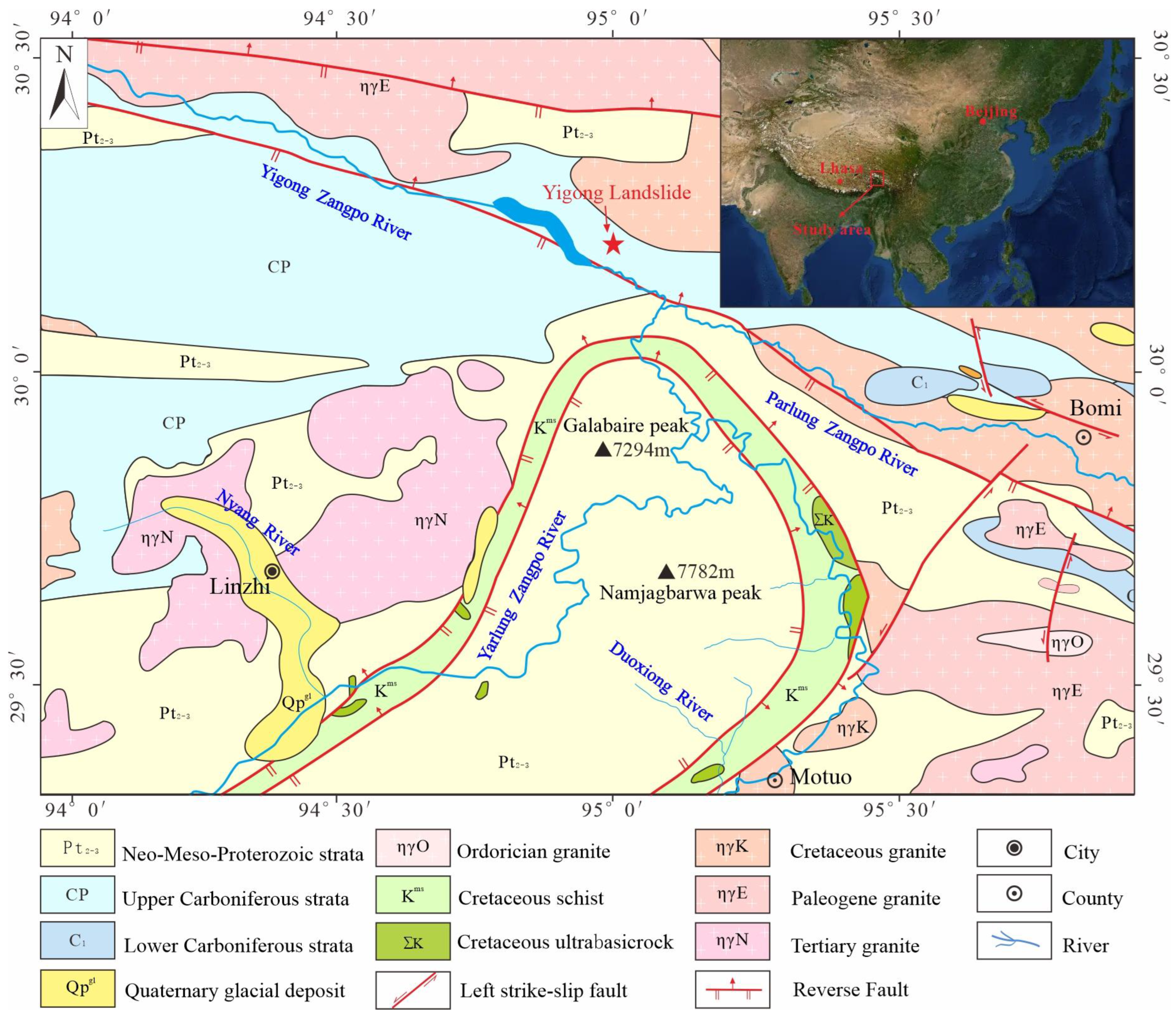

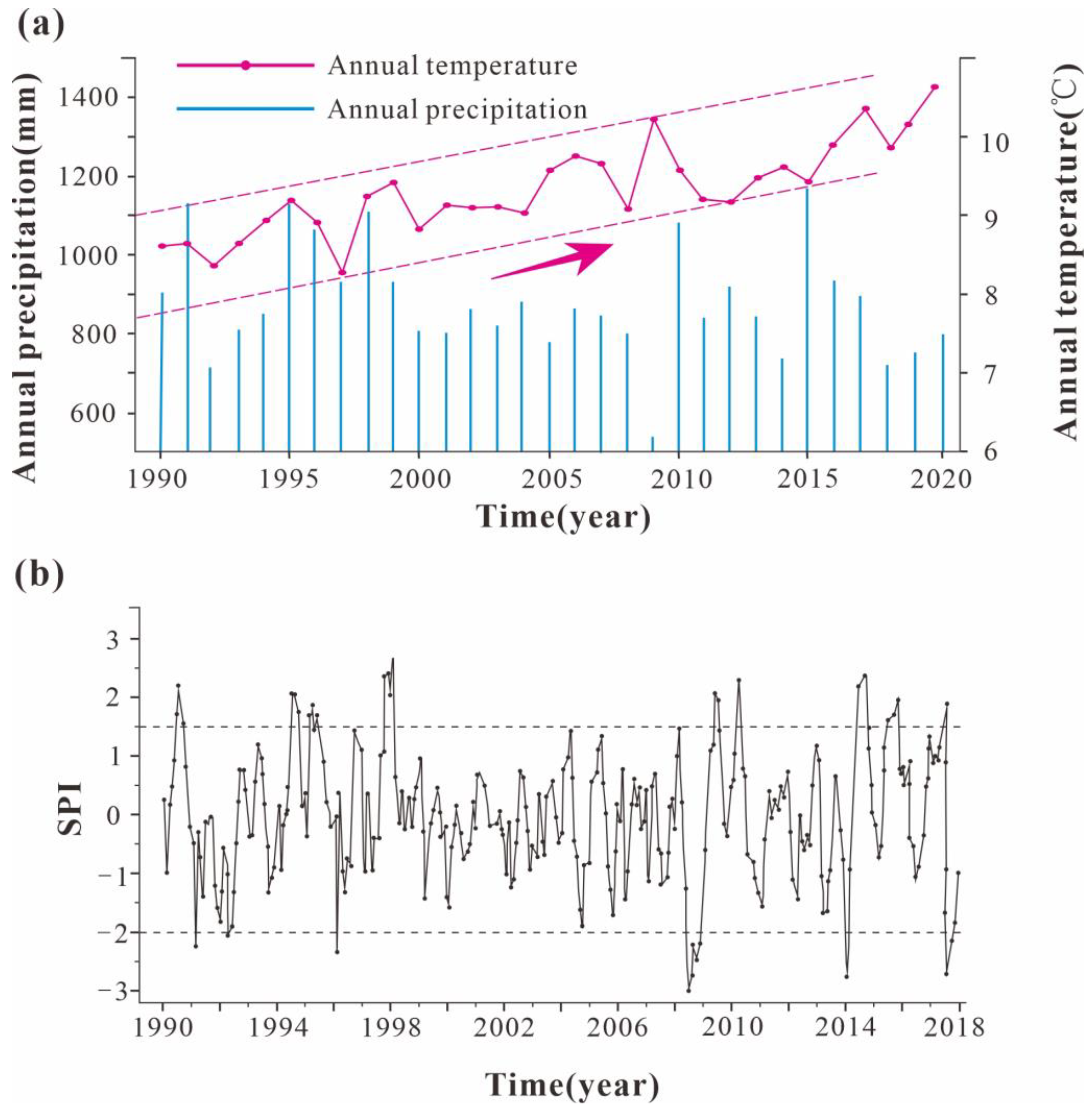
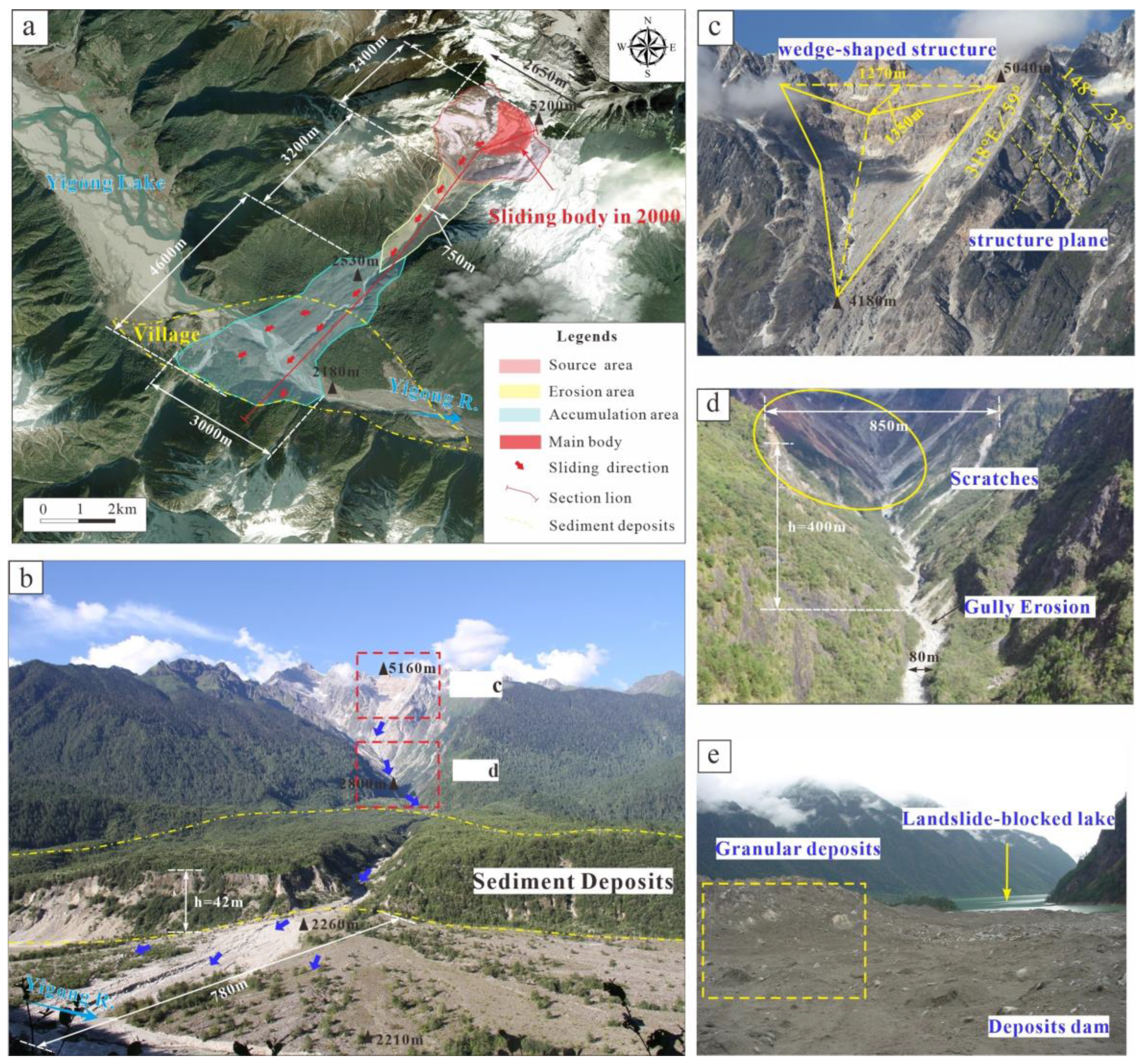
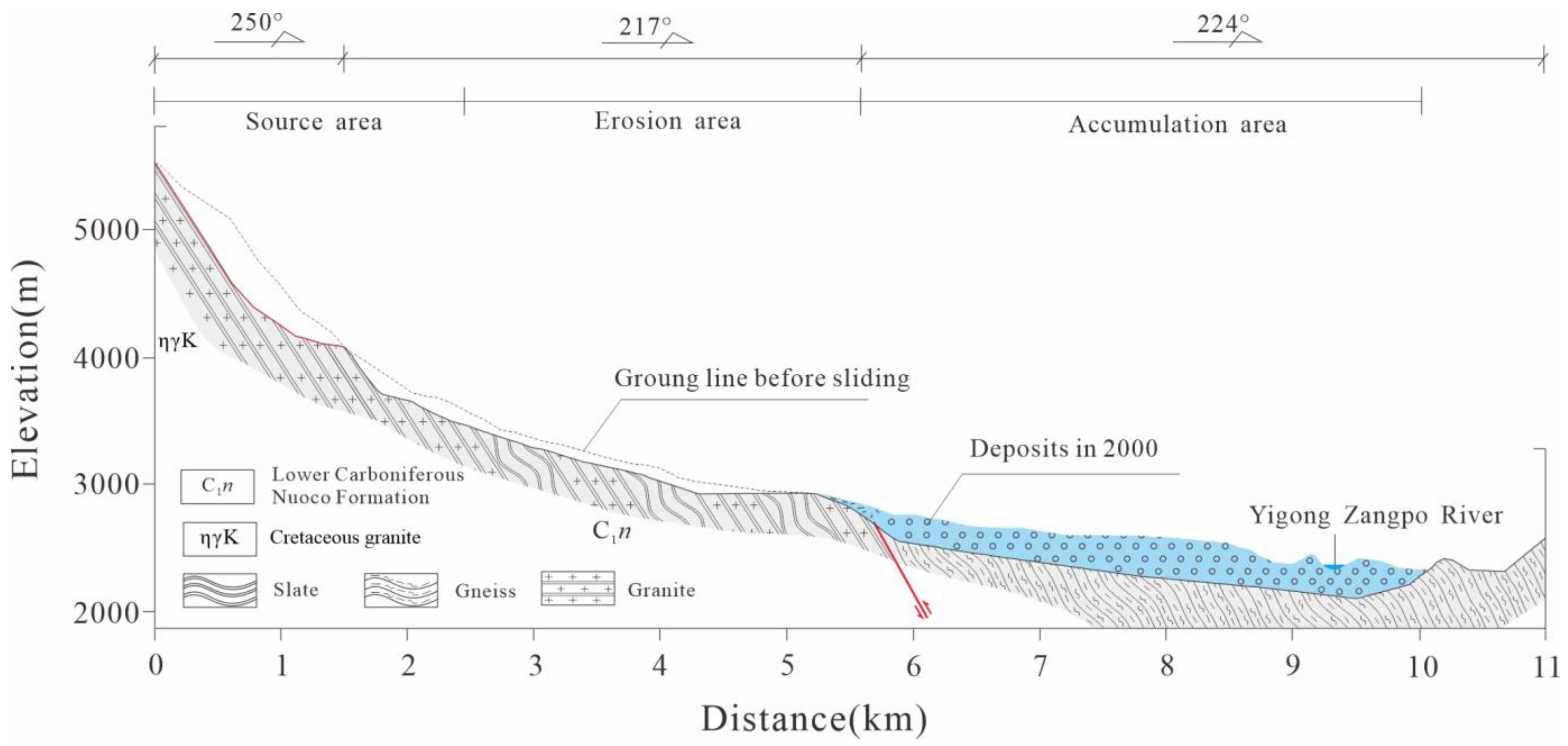
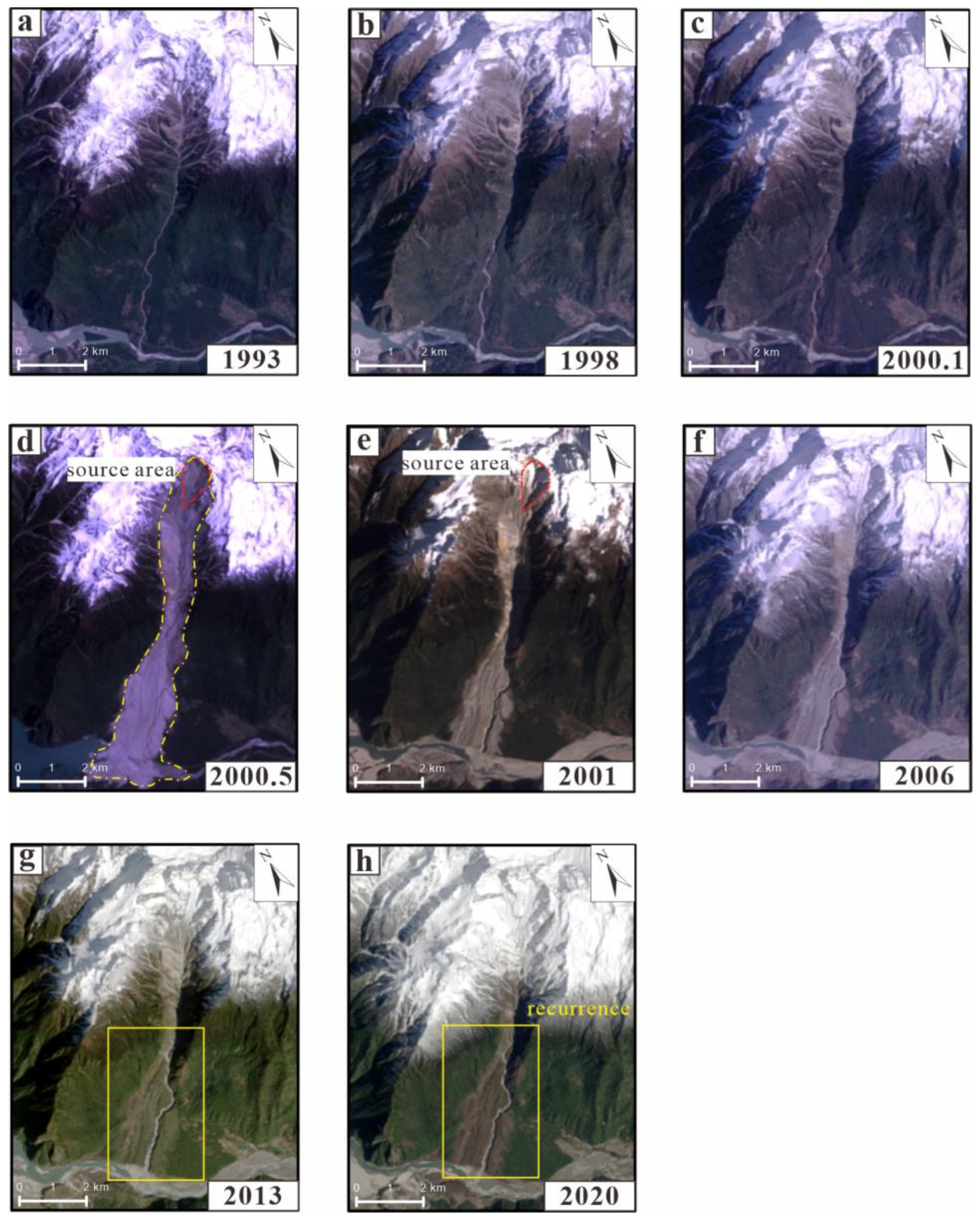

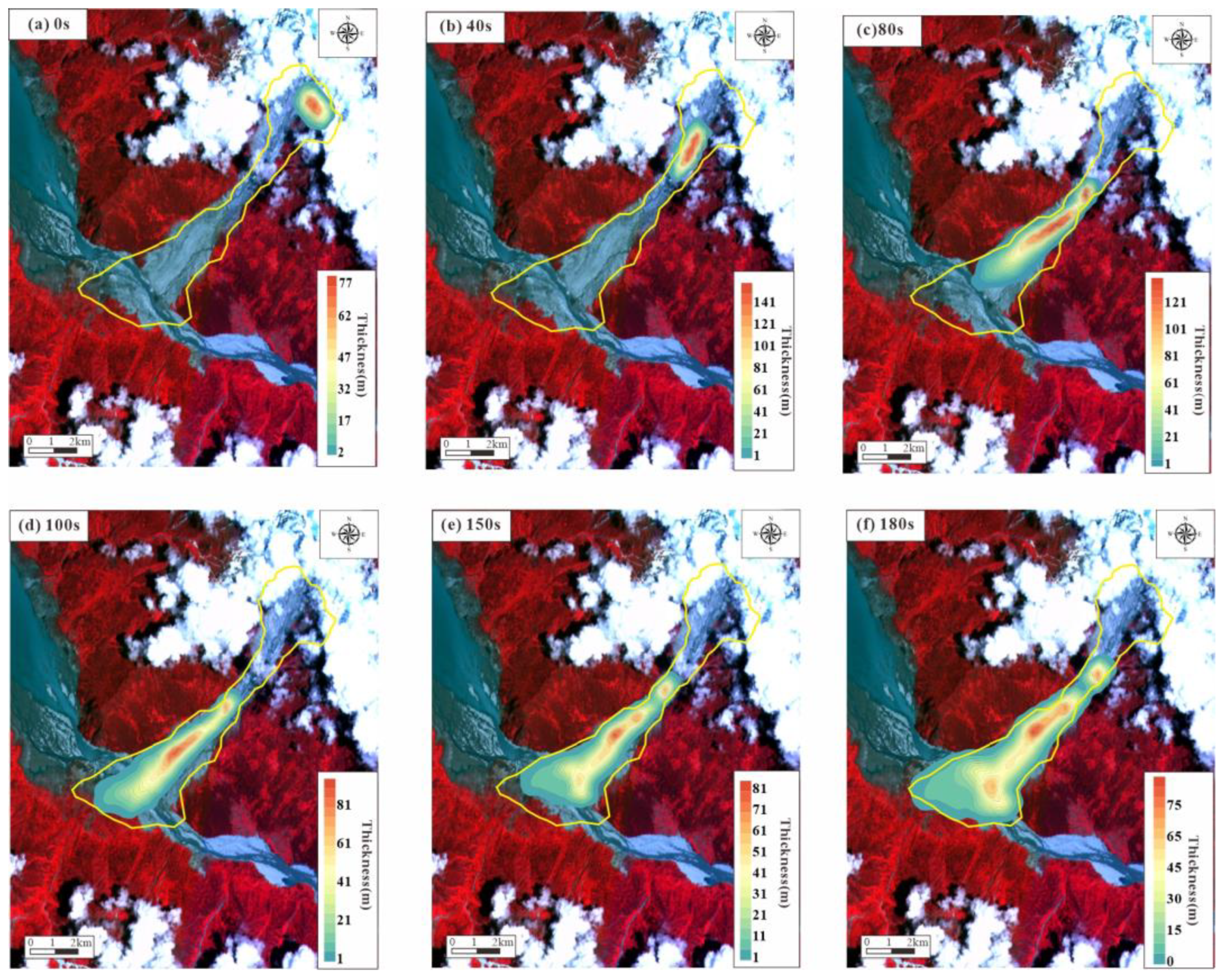
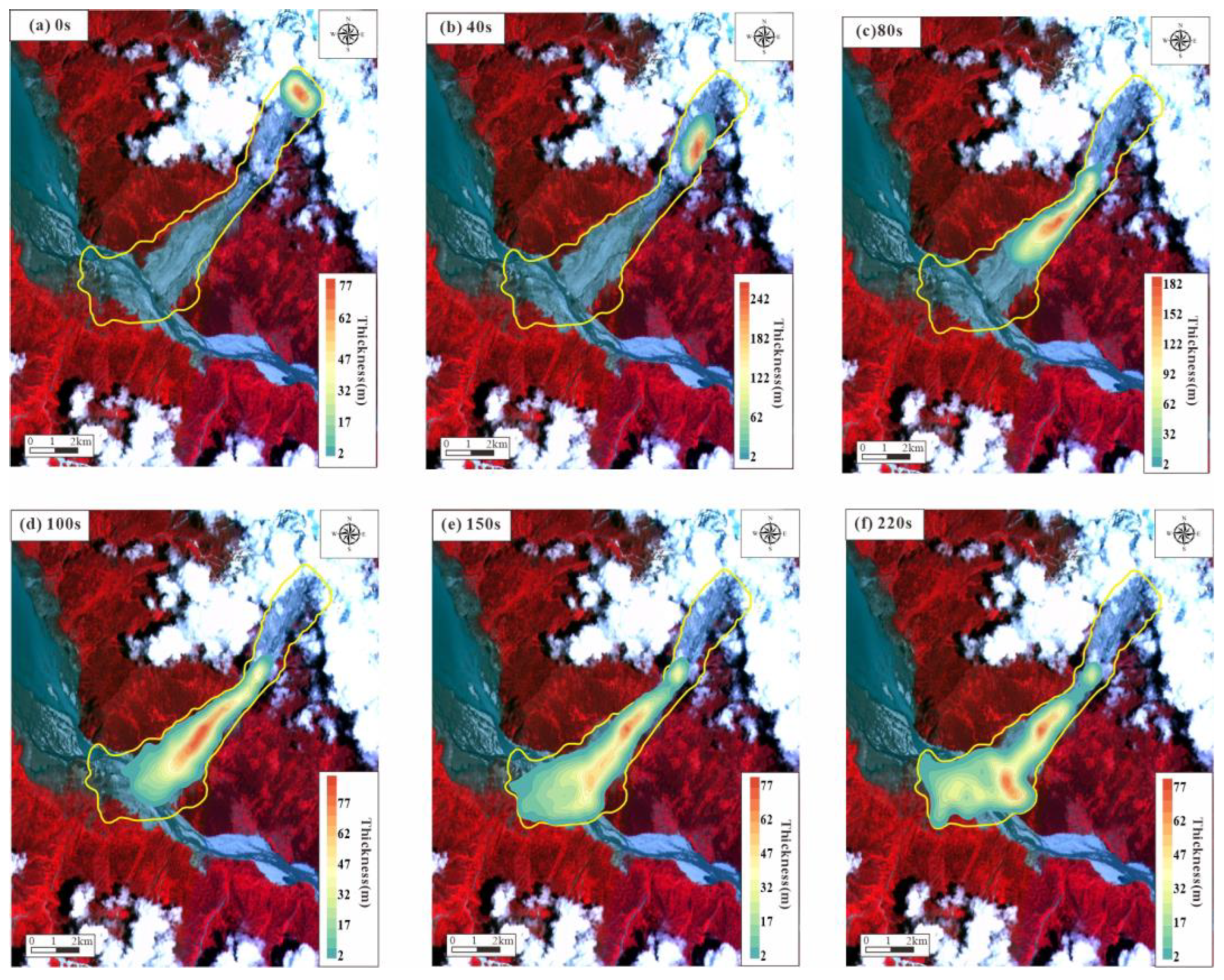
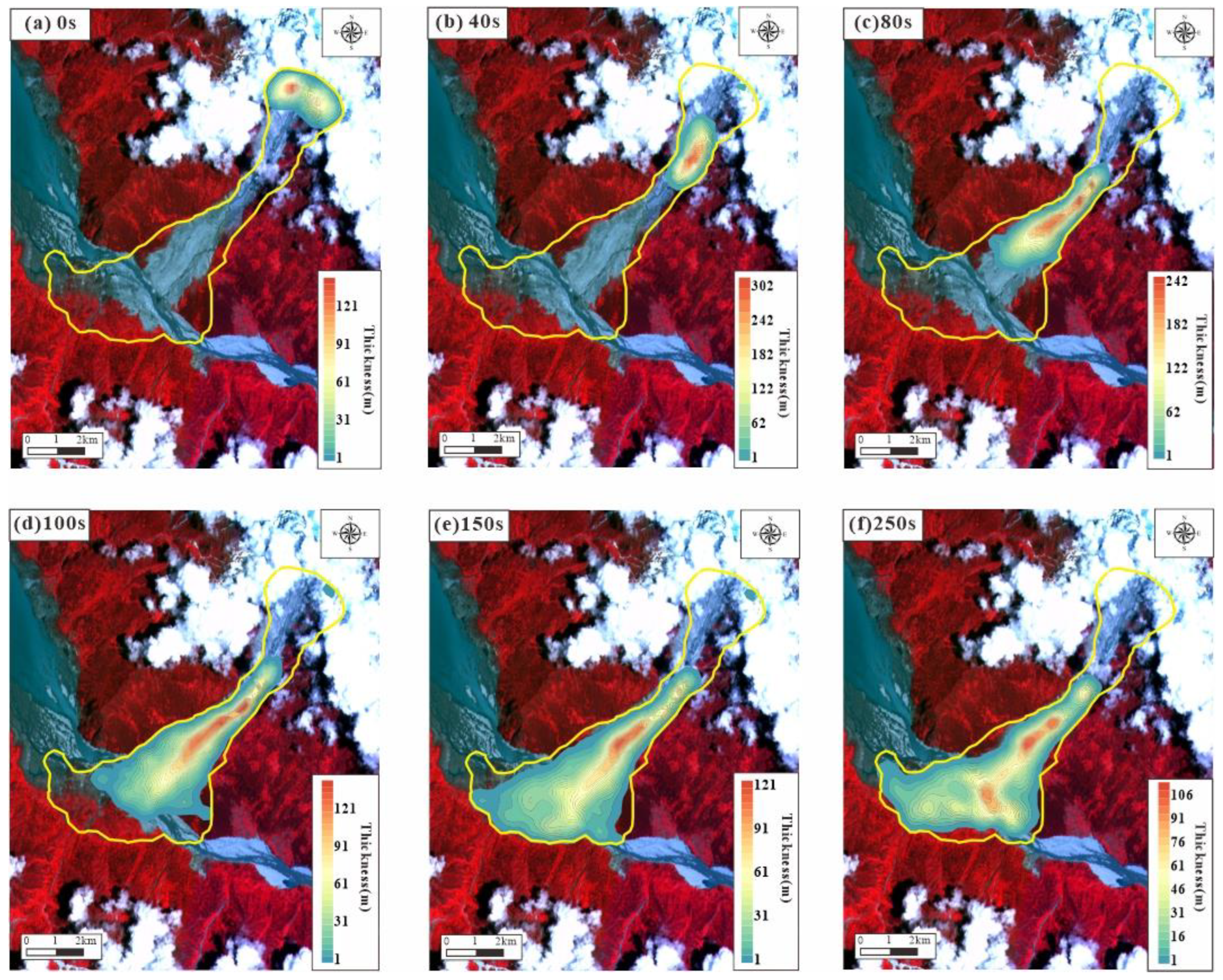
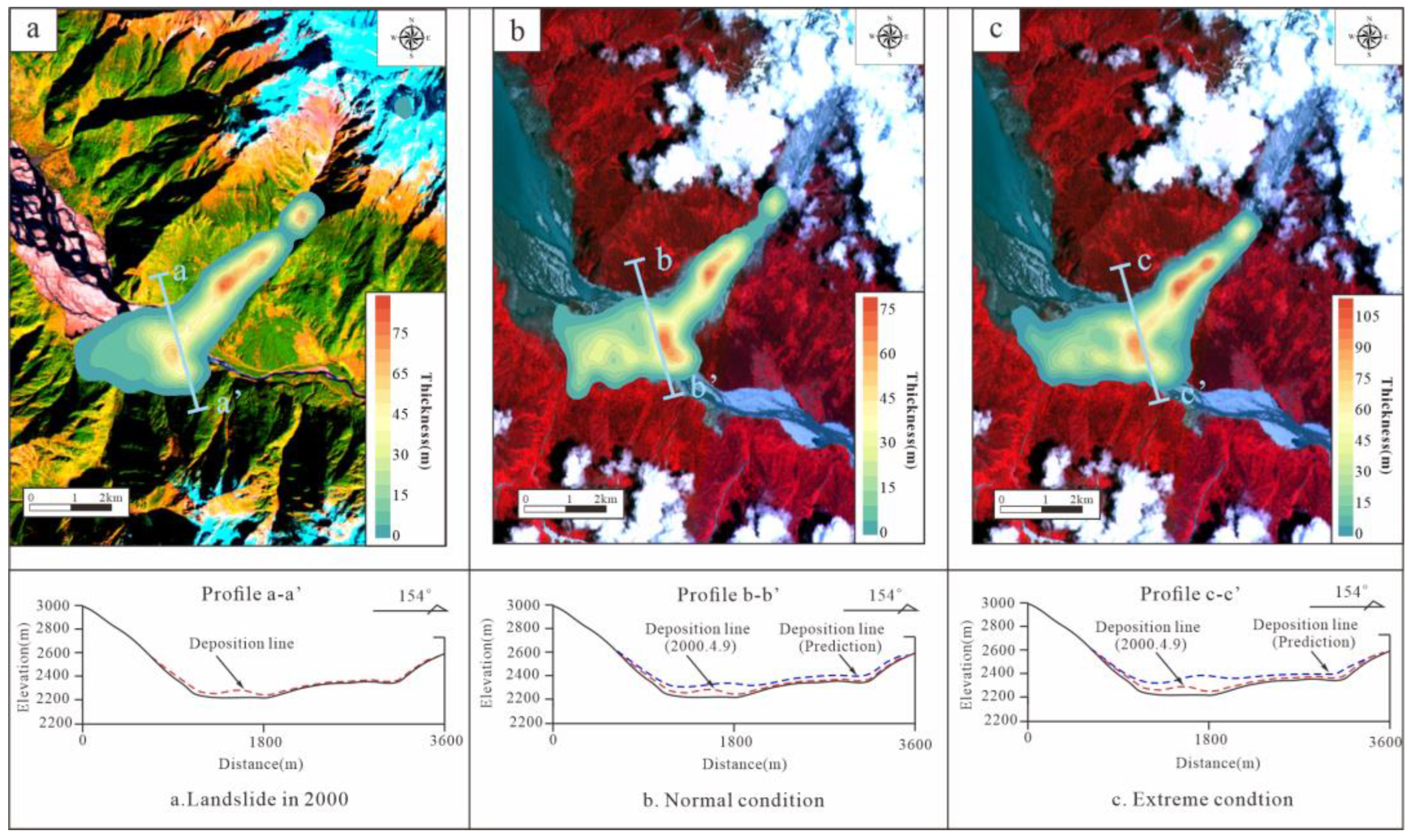
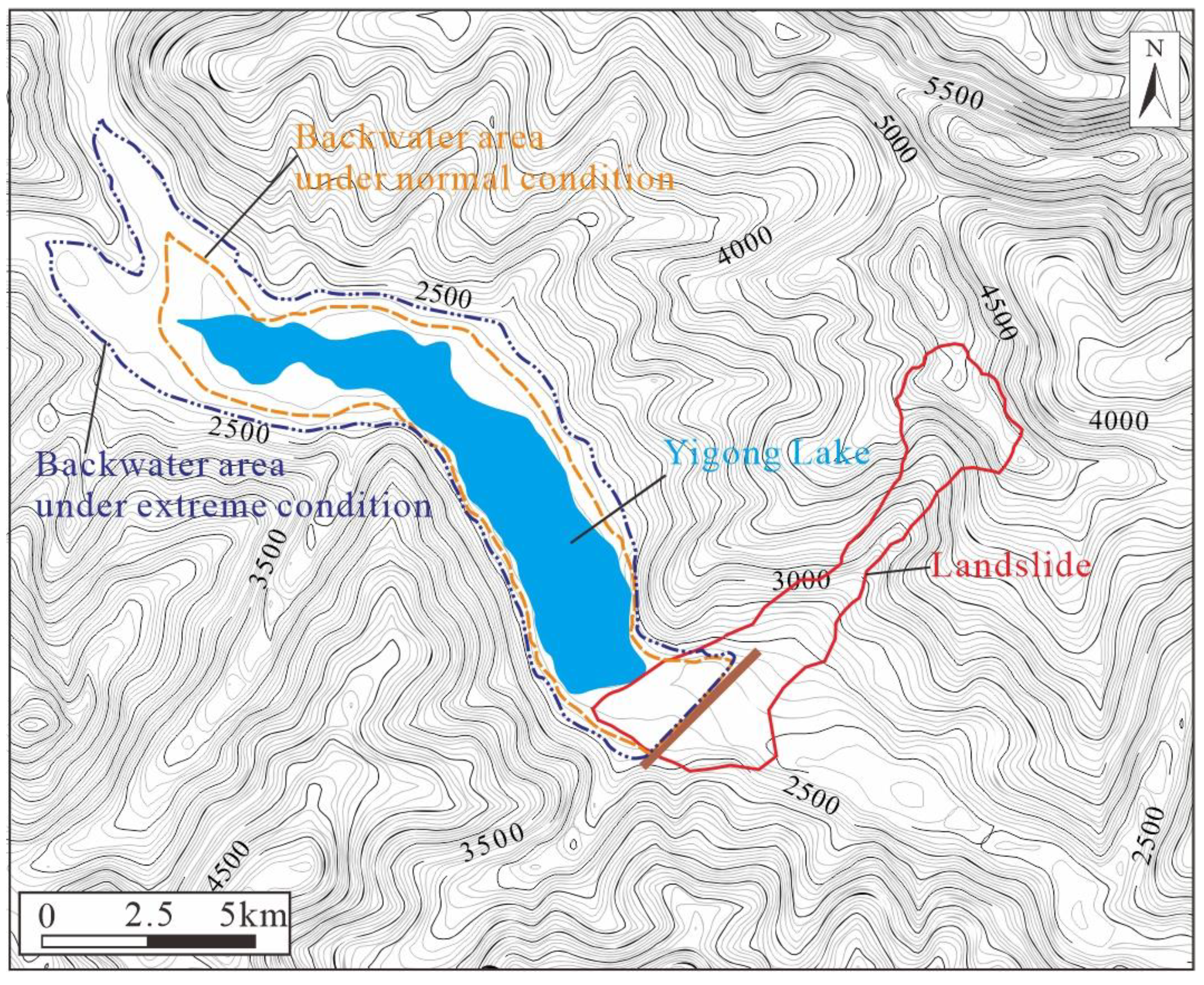

| Year | Day/Month | Satellite Type | Sensor Type | Resolution |
|---|---|---|---|---|
| 1993 | 25/05 | Landsat5 | TM | 30 m |
| 1998 | 05/12 | Landsat5 | TM | 30 m |
| 2000 | 05/011 | Landsat5 | TM | 30 m |
| 2000 | 12/05 | Landsat5 | TM | 30 m |
| 2001 | 01/12 | Landsat7 | ETM+ | 30 m |
| 2006 | 06/02 | Landsat5 | TM | 30 m |
| 2013 | 24/11 | Landsat8 | OLI | 30 m |
| 2020 | 29/02 | Landsat8 | OLI | 30 m |
| Zone | Rheology | γ (kN/m3) | φ (°) | f | ru | Max Erosion Depth (m) |
|---|---|---|---|---|---|---|
| Source area | Frictional | 24 | 19.8 | - | 0.2 | 0 |
| Erosion area | Voellmy | 20 | - | 0.08 | - | 65 |
| Accumulation area | Frictional | 20 | 20 | - | 0.3 | 0 |
Disclaimer/Publisher’s Note: The statements, opinions and data contained in all publications are solely those of the individual author(s) and contributor(s) and not of MDPI and/or the editor(s). MDPI and/or the editor(s) disclaim responsibility for any injury to people or property resulting from any ideas, methods, instructions or products referred to in the content. |
© 2023 by the authors. Licensee MDPI, Basel, Switzerland. This article is an open access article distributed under the terms and conditions of the Creative Commons Attribution (CC BY) license (https://creativecommons.org/licenses/by/4.0/).
Share and Cite
Gao, H.; Gao, Y.; Li, B.; Yin, Y.; Yang, C.; Wan, J.; Zhang, T. The Dynamic Simulation and Potential Hazards Analysis of the Yigong Landslide in Tibet, China. Remote Sens. 2023, 15, 1322. https://doi.org/10.3390/rs15051322
Gao H, Gao Y, Li B, Yin Y, Yang C, Wan J, Zhang T. The Dynamic Simulation and Potential Hazards Analysis of the Yigong Landslide in Tibet, China. Remote Sensing. 2023; 15(5):1322. https://doi.org/10.3390/rs15051322
Chicago/Turabian StyleGao, Haoyuan, Yang Gao, Bin Li, Yueping Yin, Chengsheng Yang, Jiawei Wan, and Tiantian Zhang. 2023. "The Dynamic Simulation and Potential Hazards Analysis of the Yigong Landslide in Tibet, China" Remote Sensing 15, no. 5: 1322. https://doi.org/10.3390/rs15051322





